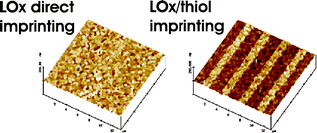One-step covalent microcontact printing approach to produce patterns of lactate oxidase
Abstract
A comparative study of three different strategies to pattern

* Corresponding authors
a
Departamento de Química Analítica y Análisis Instrumental, Universidad Autónoma de Madrid, Campus de Cantoblanco, 28049 Madrid, Spain
E-mail:
elena.casero@uam.es
Fax: 34914974931
Tel: 34914972990
b Instituto de Ciencia de Materiales de Madrid (CSIC), 28049 Madrid, Spain
A comparative study of three different strategies to pattern

 Please wait while we load your content...
Something went wrong. Try again?
Please wait while we load your content...
Something went wrong. Try again?
E. Casero, M. D. Petit-Domínguez, A. M. Parra-Alfambra, M. J. Gismera, F. Pariente, E. Lorenzo and L. Vázquez, Phys. Chem. Chem. Phys., 2010, 12, 2830 DOI: 10.1039/B922805E
To request permission to reproduce material from this article, please go to the Copyright Clearance Center request page.
If you are an author contributing to an RSC publication, you do not need to request permission provided correct acknowledgement is given.
If you are the author of this article, you do not need to request permission to reproduce figures and diagrams provided correct acknowledgement is given. If you want to reproduce the whole article in a third-party publication (excluding your thesis/dissertation for which permission is not required) please go to the Copyright Clearance Center request page.
Read more about how to correctly acknowledge RSC content.
 Fetching data from CrossRef.
Fetching data from CrossRef.
This may take some time to load.
Loading related content
